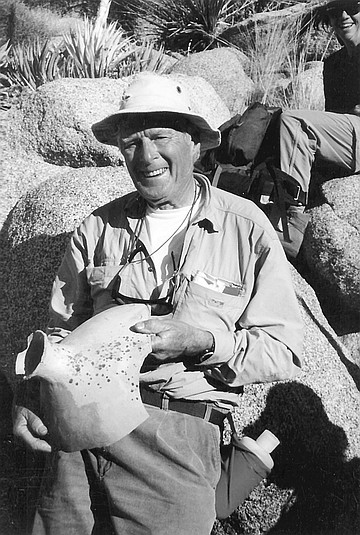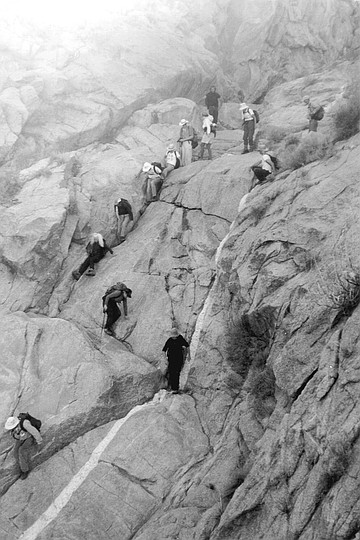 Facebook
Facebook
 X
X
 Instagram
Instagram
 TikTok
TikTok
 Youtube
Youtube

It’s no secret, and certainly not a shameful one, but Walkabout International’s regulars, both leaders and participants, have grayed in recent years. As a result, the terrain they traverse is often no more rugged than the sidewalks of La Jolla.

This weekend, however, 76-year-old hiker Al Holden will lead a Walkabout group on an eight-miler in McCain Valley that promises to be strenuous, physically challenging, even a bit daring at the outermost reaches of the trail.
McCain Valley is public land about 70 miles due east of downtown, in the In-Ko-Pah Mountains. “I like the wildness of the place,” says Holden, a retired mail carrier who lives in University Towne Centre and who has hiked that area since the 1960s.

“It’s a crosscountry paradise with rock outcroppings you can scramble onto, and little caves, and longdistance views in every direction.” Holden describes its terrain as a “high-desert transition zone.” Meaning? “You’re not on the desert floor; you’re not in the mountains. You’re in between, so you have both environments. The brush is sparse, and the ground is soft and sandy.”
There’s something besides the terrain that draws Holden and others to the place. “It’s full of Indian artifacts — pottery shards, grinding holes.” It is also one of the “most significant rock-art sites in San Diego County,” according to state archaeologist Russ Kaldenberg. Holden knows some of those sites, which date back thousands of years. “Descending down McCain Valley into Canebreak Canyon, there is a cave with Indian pictographs,” he says. “In another canyon, there’s a rock shelter that the Indians used as a summer solstice observatory. On that day, the rays of the sun shine into the roof of this shelter where the Indians drew little sunbursts. The sun strikes those symbols at sunrise.” When that happened thousands of years ago, says Holden, “the Indians knew that the season had turned.”
McCain Valley was named for George McCain, a homesteader who settled there in 1852. “The McCains were old pioneers who raised cattle and developed water sources,” says Holden. The lore of the valley includes stories about the McCains, and Holden has one of his own, featuring “Tule Jim McCain,” a member of the fourth or fifth generation.
“He was a rancher down in the lower canyon living inside the Indian reservation. There are lots of tule [pronounced ‘tooley’] bushes down there. That’s how he got the name. Well, about a dozen years ago, my son and I hiked into the McCain Valley and when we were coming out, it was getting dark and cold and starting to snow. We got to the car, but the battery was dead. So we hiked into the reservation and came upon McCain’s ranch house.
“He answered the door with a shotgun under his arm. We explained our situation, and he put us in his old pickup truck to take us to a gas station, where we could get a wrecker to tow us. Whether he was sleepy or drunk, I don’t know, but he was driving crazy, and we went sailing off the road into a meadow. So we left him with the truck and started walking. A couple of Indian people picked us up and drove us to a wrecker. We went back, fished out Jim, turned him around, and sent him home. But we had to coax the wrecker driver to go into McCain Valley. He said it was snowing too much. Finally, he did it. We went eight or nine miles on that old road — all the way in. And he towed us all the way out.”
Within the year, Tule Jim died. “He was leading a funeral for one of the Indians on the reservation. He was carrying the cross at the head of the procession, and as he was walking along, he dropped dead.”
On Saturday, Holden will deliver more commentary as he leads hikers along Gasp Ridge. “It’s a real rough ridge,” he says, “about a mile long, and at the end there’s a viewpoint at which you can look down into Carrizo Gorge and see the railroad tracks and trestles. The ridge is shaped like a battleship with the viewpoint at the tip of the bow, and the ones that want to can scramble right along the rocks and on and on until they get to the end and then scramble back.”
Those hikers who don’t want to scramble may hang back in Redondo Flat. “It’s full of Indian signs,” says Holden. “It’s obvious that it once was an Indian village. There’s a spring there. It’s a pretty little spot.”
People interested in carpooling to the trailhead should meet at 7:45 a.m. on the street in front of the First United Methodist Church, 2111 Camino Del Rio South, Mission Valley. Be prepared to drive yourself to the trailhead if no other carpoolers appear.
Everyone should bring lunch, lots of water, and be in good physical condition.


It’s no secret, and certainly not a shameful one, but Walkabout International’s regulars, both leaders and participants, have grayed in recent years. As a result, the terrain they traverse is often no more rugged than the sidewalks of La Jolla.

This weekend, however, 76-year-old hiker Al Holden will lead a Walkabout group on an eight-miler in McCain Valley that promises to be strenuous, physically challenging, even a bit daring at the outermost reaches of the trail.
McCain Valley is public land about 70 miles due east of downtown, in the In-Ko-Pah Mountains. “I like the wildness of the place,” says Holden, a retired mail carrier who lives in University Towne Centre and who has hiked that area since the 1960s.

“It’s a crosscountry paradise with rock outcroppings you can scramble onto, and little caves, and longdistance views in every direction.” Holden describes its terrain as a “high-desert transition zone.” Meaning? “You’re not on the desert floor; you’re not in the mountains. You’re in between, so you have both environments. The brush is sparse, and the ground is soft and sandy.”
There’s something besides the terrain that draws Holden and others to the place. “It’s full of Indian artifacts — pottery shards, grinding holes.” It is also one of the “most significant rock-art sites in San Diego County,” according to state archaeologist Russ Kaldenberg. Holden knows some of those sites, which date back thousands of years. “Descending down McCain Valley into Canebreak Canyon, there is a cave with Indian pictographs,” he says. “In another canyon, there’s a rock shelter that the Indians used as a summer solstice observatory. On that day, the rays of the sun shine into the roof of this shelter where the Indians drew little sunbursts. The sun strikes those symbols at sunrise.” When that happened thousands of years ago, says Holden, “the Indians knew that the season had turned.”
McCain Valley was named for George McCain, a homesteader who settled there in 1852. “The McCains were old pioneers who raised cattle and developed water sources,” says Holden. The lore of the valley includes stories about the McCains, and Holden has one of his own, featuring “Tule Jim McCain,” a member of the fourth or fifth generation.
“He was a rancher down in the lower canyon living inside the Indian reservation. There are lots of tule [pronounced ‘tooley’] bushes down there. That’s how he got the name. Well, about a dozen years ago, my son and I hiked into the McCain Valley and when we were coming out, it was getting dark and cold and starting to snow. We got to the car, but the battery was dead. So we hiked into the reservation and came upon McCain’s ranch house.
“He answered the door with a shotgun under his arm. We explained our situation, and he put us in his old pickup truck to take us to a gas station, where we could get a wrecker to tow us. Whether he was sleepy or drunk, I don’t know, but he was driving crazy, and we went sailing off the road into a meadow. So we left him with the truck and started walking. A couple of Indian people picked us up and drove us to a wrecker. We went back, fished out Jim, turned him around, and sent him home. But we had to coax the wrecker driver to go into McCain Valley. He said it was snowing too much. Finally, he did it. We went eight or nine miles on that old road — all the way in. And he towed us all the way out.”
Within the year, Tule Jim died. “He was leading a funeral for one of the Indians on the reservation. He was carrying the cross at the head of the procession, and as he was walking along, he dropped dead.”
On Saturday, Holden will deliver more commentary as he leads hikers along Gasp Ridge. “It’s a real rough ridge,” he says, “about a mile long, and at the end there’s a viewpoint at which you can look down into Carrizo Gorge and see the railroad tracks and trestles. The ridge is shaped like a battleship with the viewpoint at the tip of the bow, and the ones that want to can scramble right along the rocks and on and on until they get to the end and then scramble back.”
Those hikers who don’t want to scramble may hang back in Redondo Flat. “It’s full of Indian signs,” says Holden. “It’s obvious that it once was an Indian village. There’s a spring there. It’s a pretty little spot.”
People interested in carpooling to the trailhead should meet at 7:45 a.m. on the street in front of the First United Methodist Church, 2111 Camino Del Rio South, Mission Valley. Be prepared to drive yourself to the trailhead if no other carpoolers appear.
Everyone should bring lunch, lots of water, and be in good physical condition.
Comments